Napoleon Bonaparte: Giant of the Age
Part 8: Continental System and Opposition
Sweden had been a largely supporting partner of the Alliance in both this war and the previous one. French troops defeated a Swedish force in August 1807, taking Sweden out of the fighting. That left only the U.K. fighting France, Russia having been, by the terms of the Treaty of Tilsit, not only bound to join the Continental System but also to declare war on the U.K. The aim of the Continental System (also known as the Blocus continental or Continental Blockade) was to try to gain some advantage over the U.K., which still ruled the seas and was still financing many of the Allied war efforts on the Continent. All trade with the U.K. was banned. Even the mail could not be delivered. France had declared embargoes on British trade before, under the Directory, in October 1796 and January 1798. The result then was a strengthening of the British naval blockade of French ports. The same had happened again: After Trafalgar, the U.K. again declared a blockade of all French coastline and had the ships to enforce it. The creation of the Continental System resulted in much the same response from the U.K. (which had transformed from Great Britain in the Act of Union 1800). The London In principle, the Continental System governed the French Empire and all of its holdings, beginning with the Berlin Decree and continuing with the expansion of the borders of not only France itself but also the lands controlled by French troops. This included all or areas of Germany, Italy, the Netherlands, Poland, and Switzerland. In practice, the French governmental apparatus did not always have enough manpower to police the ports and shipping lanes of the Atlantic, Baltic, and Mediterranean. Smuggling was rampant. Initially, some countries tried to circumvent the system by having their ships fly an "acceptable" flag, even though the goods on those ships were bound to and/or from "enemy" countries. Occupied lands employed this practice on both sides of what was essentially a France–U.K. divide. As well, the more French troops were needed to fight battles on the Continent, the fewer French men and money were available to act not only as customs surveillance but also as customs administrators. The opposite was true in the relatively rare months during the existence of the Continental System in which France was not at war. Portugal refused to be bound by such a system, and the Royal Navy ruled the waves in and around Portugal at the time, so France couldn't do much about that. As the trade war escalated, Napoleon decided to send troops to Portugal, in order to force that country to comply with the blockade. During the last few months of 1807 and the first few months of 1808, more than 100,000 French troops marched into Spain, on their way to Portugal. 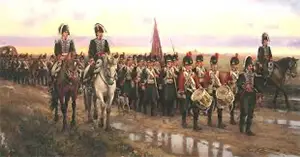
The occupation began on Oct. 12, 1807, with 28,000 French troops under Jean-Andoche Junot marching from France into Spain. Bonaparte and Spain's King Charles IV later that month signed the Treaty of Fontainebleau, by which the two monarchs agreed to share in an invasion of Portugal, with Spain adding 25,500 troops, and then divide its territory between them. The invasion began on Nov. 19, and the Portuguese royal family fled to Brazil, transferring the seat of government there. Junot occupied Lisbon on December 1. Spain had been an ally of France for many years. The two countries had recently collaborated on a plan to break the U.K. naval blockade in 1805. However, at this point in time, the Spanish king was involved in a major quarrel with the heir apparent, his oldest son, Ferdinand. The quarrel had become quite public and had divided much of the country, with both men having support from various regions. Another large force from France marched into northern Spain in February 1808 and occupied the regions of Catalonia and Navarre, including the cities of Barcelona and Pamplona. Bonaparte named Marshal Joachim Murat commander of all French troops in Spain. He entered Madrid at the head of a large army on March 23. Both Charles IV and Ferdinand pressed their case to Bonaparte, who was clearly the power behind the Spanish throne at this point, and the French emperor summoned the royal father and son to Bayonne, in France, to discuss. Bonaparte, at a meeting on May 5, forced Charles IV to abdicate and then forced both king and king-in-waiting to step aside and claimed the throne for himself. He promptly then made his brother, Joseph, King of Spain. (He had been King of Naples). A large-scale uprising ensued. The people of Spain didn't at all want a foreigner ruling their country, and they put up quite a fight during a number of years, waging guerrilla war and requiring France to keep many more troops in the country than it otherwise would have. Local militias known as Miquelets won several battles against French troops. French supplies of men, money, and weapons were not limitless, and the occupation army grew to such an extent that it had a bearing on actions that the French Army could take elsewhere in Europe. Joseph Bonaparte entered Madrid on July 20, after the French forces had restored stability in the capital. He was crowned King of Spain on July 25. Not long afterward, the uprising forced him to flee. At the same time, other French troops had carried on into Portugal, which, naturally didn't appreciate the invasion. Troops from the U.K. came to Portugal's aid, beginning in 1808, and the Peninsular War began. Gen. Arthur Wellesley and 15,000 U.K. troops landed in Portugal in August 1808 and began forcing French troops back into Spain. These actions culminated in a U.K. victory at Vimeiro, on August 21, forcing Junot to leave Portugal altogether. 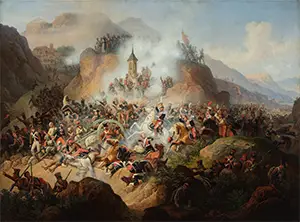
In response, Napoleon himself led an invasion of Spain by 200,000 experienced soldiers, overwhelming the Spanish troops, retaking Madrid on December 1, and restoring his brother to the throne. French troops made gains elsewhere in Spain, restoring some sense of the order that had accompanied the initial invasion just as an English-Portuguese force under Sir John Moore was advancing over the Iberian border and into Spain. The U.K. troops didn't get very far or provide much in the way of support; by the end of the year, they had retreated back into Portugal and most of them sailed back to the U.K. (One who didn't was Moore, the commander, killed in the fighting that preceded the escape.) Seeing this, and hearing of trouble with Austria, Napoleon returned to France, in January 1809. Left in charge of the French army in Spain was Marshal General Jean de Dieu Soult. Bonaparte was in Paris, not long returned from Spain, when he heard of a surprise Austrian attack. He had negotiated an agreement with Tsar Alexander of Russia, at the Congress of Erfurt in 1808. Russia had agreed to fight with France if it faced another war against Austria. The Austrian army, full of new recruits as a result of a recent mass conscription, smashed their way into Bavaria on April 10, 1809. That was one part of the plan. The other was to invade Italy, which the Austrians did under Archduke John. The French under Prince Eugéne had little trouble sending the Austrian force back out of northern Italy. The Austrians initially suffered defeat, in the Duchy of Warsaw, on April 19 and then, after a well timed counterattack by France that included a victory at Echmühl, withdrew from Bavaria. Bonaparte launched a swift attack across the Danube but was
Back in charge of the Anglo-Portuguese forces in 1811 was Arthur Wellesley, more well-known as the Duke of Wellington. He set about reorganizing the troops and then set about defeating the French. The allied force clashed with Soult at Porto on May 12, and the result was a French retreat. Wellesley's troops marched into Spain, joined forces with a Spanish force, and marched on into the Spanish heartland. 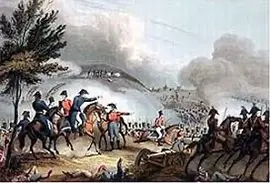
A change in leadership, from Masséna to Auguste de Marmont, brought no new success for France. Throughout 1811 and 1812, the allied force gained more and more ground. As French forces continued to be pinned down defending against guerrilla attacks all over the country, Wellington and his troops were relatively free to move relentlessly on. At the height of occupation, France had committed 300,000 troops to the effort to control Portugal and Spain. Because of the fierceness of the opposition within Spain, however, the French were able to count on only about one-quarter of that occupation force to do battle with England and Portugal at any one time. Even so, at the end of 1811, French troops occupied the vast majority of Spanish territory. Wellington went on the offensive in 1812, entering Spain at the head of an allied army and seizing the strongholds of Ciudad Rodrigo (in January) and Badajoz (in April). In July, the allies defeated the French at the Battle of Salamanca. A month later, Wellington seized Madrid. Next page > Trouble in the North > Page 1, 2, 3, 4, 5, 6, 7, 8, 9, 10, 11, 12 |
|
Social Studies for Kids
copyright 2002–2025
David White



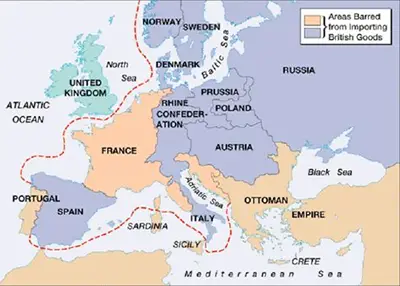 While in the Prussian capital, Bonaparte had issued the Berlin Decree, on Nov. 21, 1806. This was the creation of the
While in the Prussian capital, Bonaparte had issued the Berlin Decree, on Nov. 21, 1806. This was the creation of the 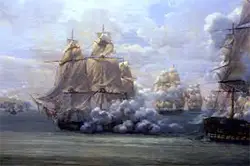 government in 1807 issued a series of Orders in Council that beefed up that blockade and took things one step further, requiring any ships flying a neutral flag (meaning not one from either France or the U.K.) to report to a U.K. report for inspection and for payment of dues and licensing fees. France countered with the Milan Decrees in late 1807 that gave French ships the power to declaring that any ships that satisfied the U.K.'s new port conditions could be classified as enemy ships and, therefore, permissible to capture.
government in 1807 issued a series of Orders in Council that beefed up that blockade and took things one step further, requiring any ships flying a neutral flag (meaning not one from either France or the U.K.) to report to a U.K. report for inspection and for payment of dues and licensing fees. France countered with the Milan Decrees in late 1807 that gave French ships the power to declaring that any ships that satisfied the U.K.'s new port conditions could be classified as enemy ships and, therefore, permissible to capture.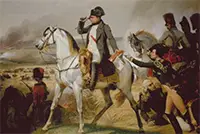 stymied at Aspern-Essling, on May 22. Austrian forces did not follow up with any sort of significant moves, allowing Bonaparte to seize the initiative. French troops won the Battle of Wagram, in July, followed that up with another victory (at Znaim), and then occupied Vienna, for the second time in recent memory. Austria's defeats left it in a very vulnerable position, and its leaders were forced to agree to the terms of the Treaty of Schönbrunn, on October 14. Among those terms were requirements for Austria to join the
stymied at Aspern-Essling, on May 22. Austrian forces did not follow up with any sort of significant moves, allowing Bonaparte to seize the initiative. French troops won the Battle of Wagram, in July, followed that up with another victory (at Znaim), and then occupied Vienna, for the second time in recent memory. Austria's defeats left it in a very vulnerable position, and its leaders were forced to agree to the terms of the Treaty of Schönbrunn, on October 14. Among those terms were requirements for Austria to join the 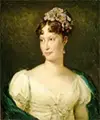 As a result of this treaty, Bonaparte found it easier to marry again, to Marie Louise, the daughter of the Austrian emperor. He had divorced his first wife, Joséphine, in late 1809, ostensibly because he desperately wanted a son to succeed him and he and she had thus far not produced one. Napoleon's new wife gave birth to a baby boy on March 20, 1811; they named the boy Napoleon and proclaimed him King of Rome and the heir apparent to the French throne.
As a result of this treaty, Bonaparte found it easier to marry again, to Marie Louise, the daughter of the Austrian emperor. He had divorced his first wife, Joséphine, in late 1809, ostensibly because he desperately wanted a son to succeed him and he and she had thus far not produced one. Napoleon's new wife gave birth to a baby boy on March 20, 1811; they named the boy Napoleon and proclaimed him King of Rome and the heir apparent to the French throne.
